






[Home] » [Press Release]
Developed an open-source local 5G system that significantly suppresses out-of-band leakage power and enables high-frequency resource utilization
-Accelerate social implementation of simple, compact local 5G that can also be connected to commercial terminals-
| Digital Communications Laboratory led by Professor Hiroshi Harada, Associate Professor Keiichi Mizutani, and Master's course student Kazuki Takeda of the Graduate School of Informatics, Kyoto University (hereafter referred to as Kyoto University), has developed a simple and compact local 5G system capable of connecting to both base stations and commercial terminals. This system utilizes a UTW-OFDM method to significantly suppress out-of-band leakage power and make high-density use of frequency, alongside a terminal use bandwidth adaptive control technology that can adaptively control the frequency band used both by the base stations and the connected terminals. This achievement will accelerate the spread of local 5G systems by making it possible to develop simple 5G systems that can be connected to commercial terminals within a limited local scope, such as offices and factories. |
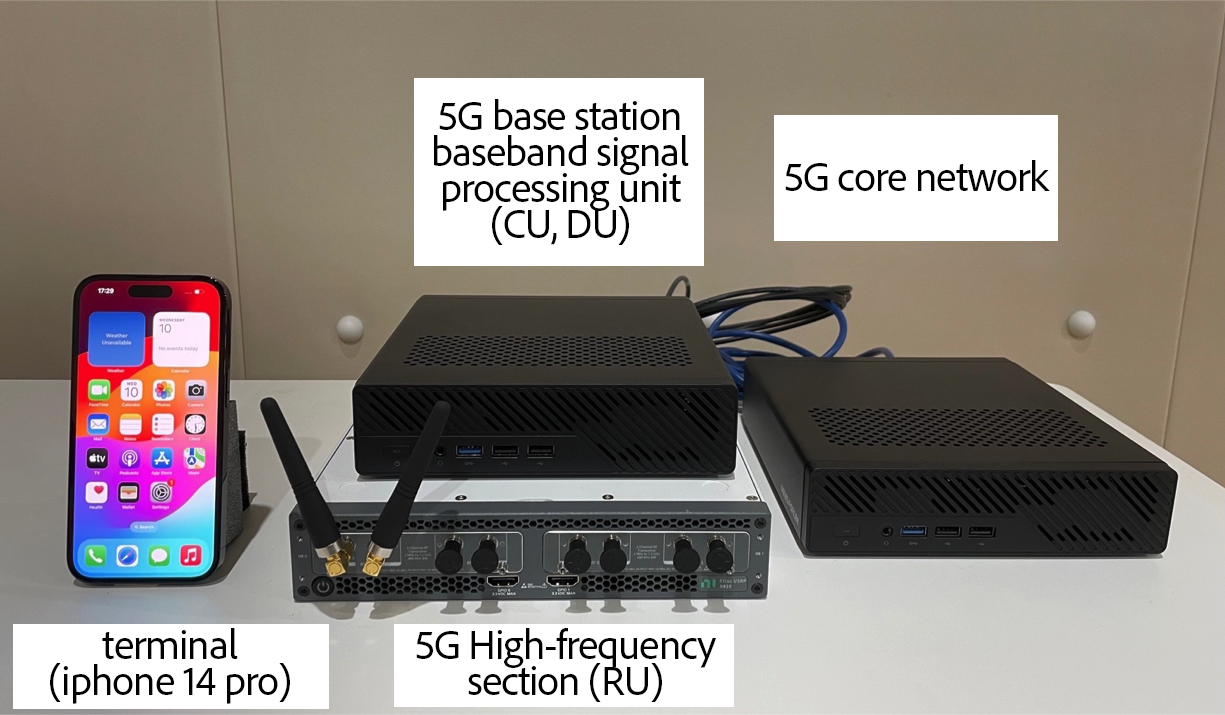
|
Background
Currently, multiple cell-phone operators provide 5G systems, and new applications are being developed to leverage the ultrahigh speed, high capacity, low latency, and numerous simultaneous connections offered by 5G systems. In addition, the use of 5G systems is not limited to cell-phone operators. Local 5G systems are also becoming popular, and various entities, such as local businesses and municipalities, use 5G as a self-managed wireless communication system in limited areas, primarily within buildings or premises. Compared to Wi-Fi and other wireless LANs, local 5G systems are based on radio station licenses, which enable stable communication speeds. However, the high cost of radio equipment and the inability to use commercial terminals limit the advancements in this field. To promote the spread of local 5G, it is necessary to develop small wireless base stations and core networks, such as Wi-Fi access points, to which commercial terminals can connect. Furthermore, the widespread use of such compact local 5G requires a large number of frequency channels in a limited frequency band, which in turn requires significant suppression of out-of-band leakage power and high-density use of frequency. To make this possible, it is necessary to incorporate a technology that adaptively controls the frequency bands used both by the base station and the connected terminals in the local 5G system.
Research Methods and Results
We successfully developed a compact local 5G system (core network and base station) that significantly suppresses the out-of-band leakage power and adaptively controls the frequency bands used both by the base station and the terminals connected to it (Figure 1). The following five major achievements in this research are as follows:
- Using open-source software that enables 5G NR (hereafter referred to as 5G software), the baseband processing functions (CU and DU functions) and the core network functions of a 5G NR base station and core network, respectively, are realized in the software within two small PCs. (Figure 1 shows the external appearance, and Table 1 lists the basic specifications.)
- The function that was added to the 5G software that processes the downlink signals of this base station to realize the UTW-OFDM method significantly suppresses the out-of-band leakage power and enables high-density use of frequencies.
- The edge-cut scheduling method (a bandwidth-adaptive control technology that adaptively controls the frequency band used by terminals connected to the base station) was added to the 5G software that processes the uplink signals of the base station.
- Modulation and demodulation in the local 5G operational frequency band (4.9 GHz band) were realized by connecting a software radio to a small PC equipped with the baseband signal processing unit of a 5G NR base station.
- The local 5G base station was connected to a commercial terminal (iPhone 14 Pro), and the base station successfully communicated with it. The transmission frequency bandwidth of the commercial terminal could be varied remotely from the base station (Figure 2).
Kyoto University is the first and only university in Japan to join the OAI (OpenAirInterface) Software Alliance, which provides open-source software for the development of 5G-NR radios. The UTW-OFDM scheme strongly suppresses discontinuities between adjacent symbols by shaping the waveform in a long time window, which results from out-of-band unwanted emissions that lead to increased bandwidth utilization and efficiency degradation (Figure 3), in contrast to the CP-OFDM scheme used in 5G. In the edge-cut scheduling method (a terminal bandwidth adaptive control technique), the base station schedules and controls the terminals to reduce the frequencies used to suppress out-of-band unwanted emissions when such signal emissions by the terminals must be limited (Figure 4). The developed base station and a commercial terminal (iPhone 14 Pro) were placed in an anechoic chamber, and experiments were conducted to measure the out-of-band radiated power and maximum data transmission rate (throughput) of the base station and the terminal, respectively. The transmission power was measured at 0 dBm (1 mW) and 10 dBm (10 mW) (Figure 2). The results of the shielded box measurements show that when the base station transmit power was 0 dBm, the UTW-OFDM method was able to suppress the out-of-band radiation power by approximately 22 dB, whereas when the transmit power was 10 dBm, it was able to suppress it by approximately 18 dB (Figure 5). The terminal transmit power was suppressed by approximately 11 dB using the edge-cut scheduling method (Figure 6). Furthermore, when measured using the Open Speed Test application in the anechoic chamber environment, as shown in Figure 2 (the distance between the transmitter and receiver is approximately 12 m), maximum data transmission rates of 164.8 Mbps (transmit power 10 dBm) and 132.1 Mbps (transmit power 0 dBm) were achieved for the downlink from the base station to the terminal, and 56.1 Mbps (transmit power 10 dBm) and 48.2 Mbps (transmit power 0 dBm) for the uplink from the terminal to the base station (Table 2).
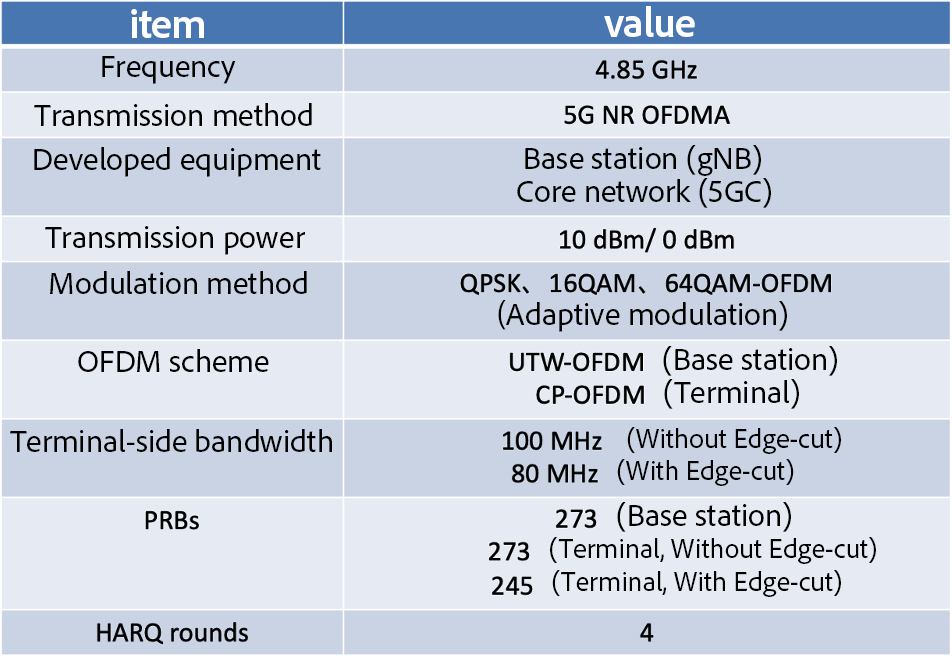
|
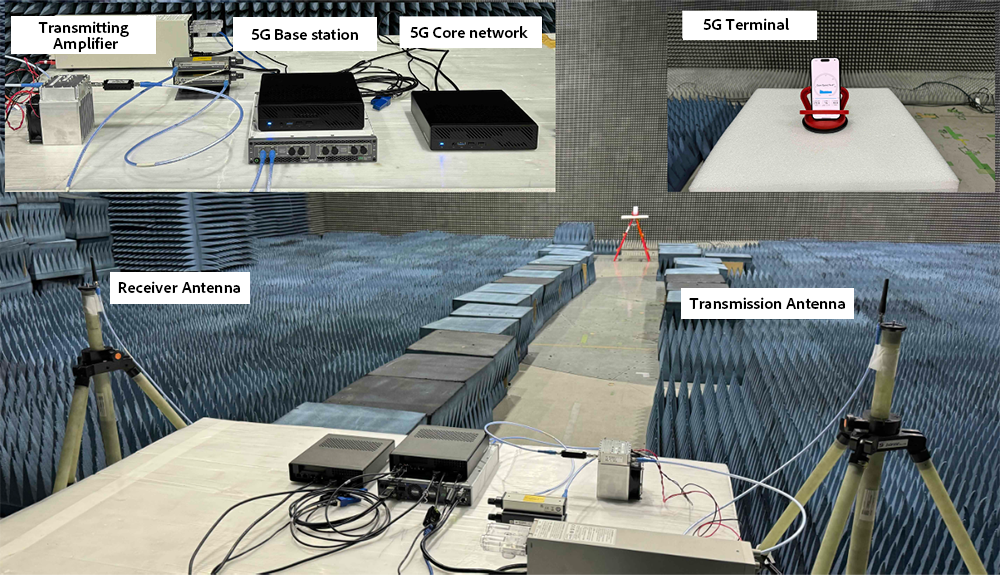
|
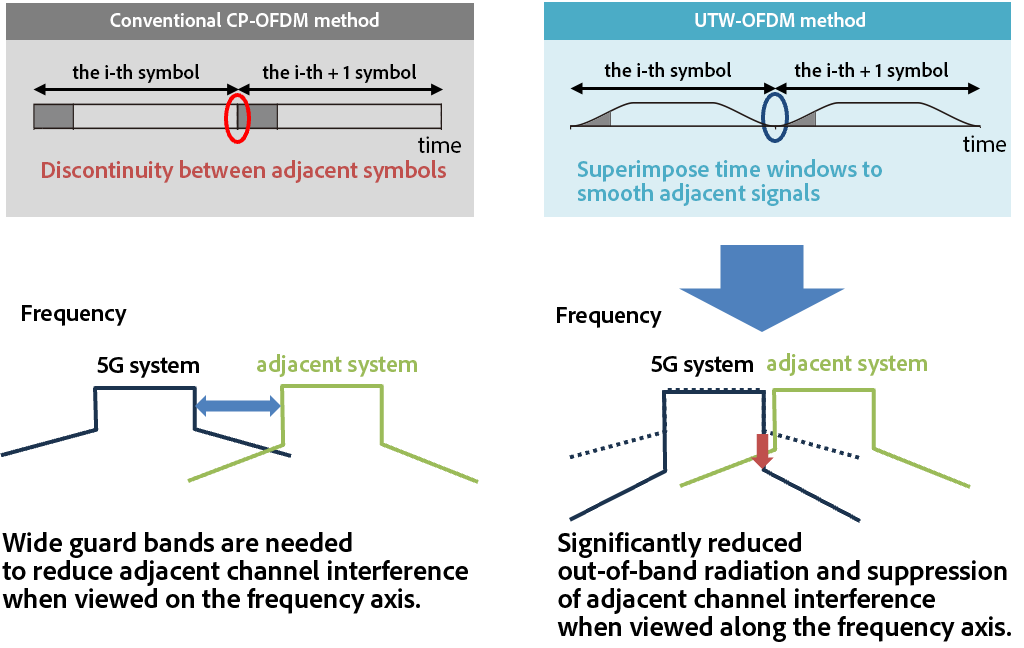
|
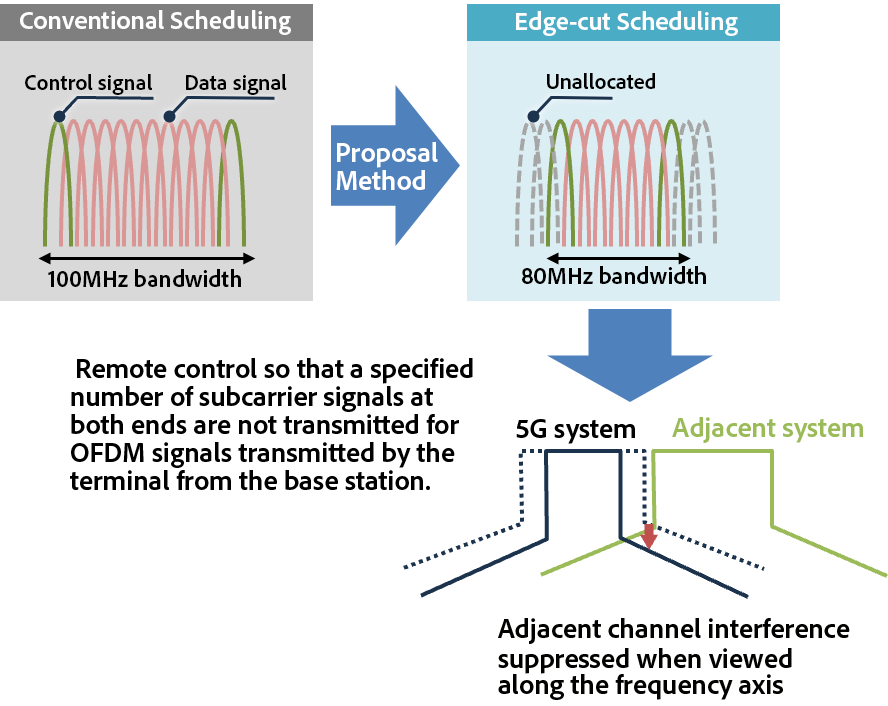
|
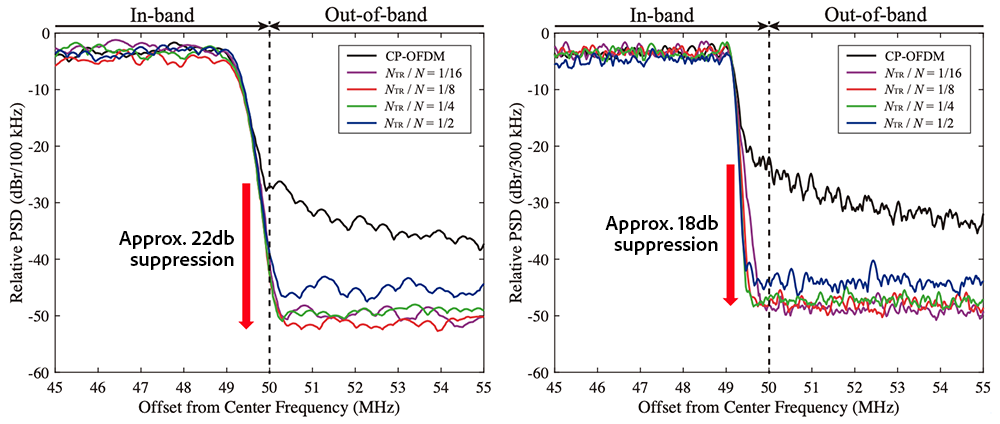
|

|

|
Impacts and Future Plans
This achievement has proved that using the actual equipment, it is possible to realize a small local 5G system with a simple configuration. This can also be connected to commercial terminals and has controllable out-of-band leakage power. This success can facilitate the development of simple 5G systems that can be connected to commercial terminals within a limited local area, such as an office or factory (like wireless LAN access points), and can accelerate the spread of local 5G systems. In the future, the transmission characteristics in various application fields using such radio equipment will be analyzed, and the proposed system will be developed for commercial use.
Acknowledgements
This research was conducted as part of a research project commissioned by the National Institute of Information and Communications Technology (JPJ010017C07501) and the Ministry of Internal Affairs and Communications (JPJ000254). Experiments were conducted in an anechoic chamber at the Microwave Energy Transmission Laboratory (METLAB) of the Research Institute for Sustainable Humanosphere, Kyoto University.
Terminologies
» 1. local 5G
Unlike nationwide 5G services provided by cell-phone operators, 5G systems are installed, licensed, and self-operated by various entities, such as companies and municipalities, in their own buildings and premises and are customized to individual regional and industrial needs. Currently, the 4.9 and 28 GHz frequency bands are allocated for local 5G.
» 2. 5G New-Radio
It is a radio interface adopted in 5G and standardized by the International Standardization Organization 3GPP (3rd Generation Partnership Project). This enables flexible signal generation for various applications.
» 3. OAI(OpenAirInterface) software Alliance
The OAI Alliance was established in 2014 with the goal of building 5G using open-source software. By installing the 5G NR software provided by the OAI Alliance on a PC or other device, it is possible to achieve the signal processing functions of the 5G system (core network, base station, and terminals) established by the 3GPP standardization organization. With suitable modifications and additional software, this system can aid various research and development activities. Kyoto University is the first university in Japan to join the alliance officially.
|
Contact Information |
|
[For Research Inquiries] |
|
[For Press and Media Inquiries] *Please change [at] to @ |